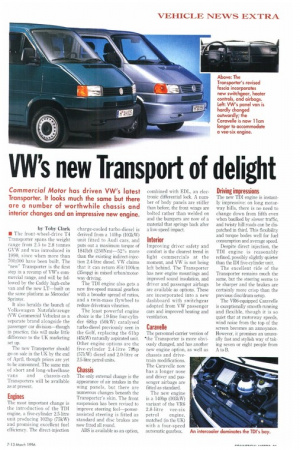VW's new Transport of delight
Page 23

If you've noticed an error in this article please click here to report it so we can fix it.
Commercial Motor has driven VW's latest Transporter. It looks much the same but there are a number of worthwhile chassis and interior changes and an impressive new engine.
by Toby Clark I The front-wheel-drive T4 Transporter spans the weight range from 2.5 to 2.8 tonnes GVW and was introduced in 1990, since when more than 700,000 have been built. The "new" Transporter is the first step in a revamp of VW's commercial range, and will be followed by the Caddy high-cube van and the new LT—built on the same platform as Mercedes' Sprinter.
It also heralds the launch of Volkswagen Nutzfahrzeuge (VW Commercial Vehicles) as a separate brand alongside the passenger car division—though in practice, this will make little difference to the UK marketing set up.
The new Transporter should go on sale in the UK by the end of April, though prices are yet to be announced. The same mix of short and long-wheelbase vans and chassis-cab Transporters will be available as at present.
Engines
The most important change is the introduction of the TDI engine, a five-cylinder 2.5-litre unit producing 102hp (75kW) and promising excellent fuel efficiency. The direct-injection charge-cooled turbo-diesel is derived from a 140hp (103kW) unit fitted to Audi cars, and puts out a maximum torque of 184Ibft (250Nm)-52% more than the existing indirect-injection 2.4-litre diesel. VW claims that it can return 8lit/100km (35mpg) in mixed urban/motorway driving.
The TDI engine also gets a new five-speed manual gearbox with a broader spread of ratios, and a twin-mass flywheel to reduce drivetrain vibration.
The least powerful engine choice is the 1.9-litre four-cylinder 68hp (50kW) catalysed turbo-diesel previously seen in the Golf, replacing the 61hp (45kW) naturally aspirated unit. Other engine options are the five-cylinder 2.4-litre 73hp (57kW) diesel and 2.0-litre or 2.5-litre petrol units.
Chassis
The only external change is the appearance of air intakes in the wing panels, but there are numerous changes beneath the Transporter's skin. The front suspension has been revised to improve steering feel—powerassisted steering is fitted as standard and disc brakes are now fitted all round.
ABS is available as an option, combined with F.,DL, an electronic differential lock. A number of body panels are stiffer than before, the front wings are bolted rather than welded on and the bumpers are now of a material that springs back after a low-speed impact.
Interior
Improving driver safety and comfort is the clearest trend in light commercials at the moment, and VW is not being left behind. The Transporter has new engine mountings and improved sound insulation, and driver and passenger airbags are available as options. These are incorporated into a new dashboard with switchgear adopted from VW passenger cars and improved heating and ventilation.
Caravelle
The new engine is a 140hp (103kW) variant of the VR6 2.8-litre vee-six petrol engine, matched (in the UK) with a four-speed automatic gearbox.
Driving impressions
The new ID! engine is instantly impressive: on long motorway hills, there is no need to change down from fifth even when baulked by slower traffic, and twisty hill roads can be dispatched in third. This flexibility and torque bodes well for fuel consumption and average speed.
Despite direct injection, the TDI engine is reasonably refined, possibly slightly quieter than the IDI five-cylinder unit.
The excellent ride of the Transporter remains much the same, but the steering seems to be sharper and the brakes are certainly more crisp than the previous disc/drum setup.
The VR6-equipped Caravelle is exceptionally smooth-running and flexible, though it is so quiet that at motorway speeds, wind noise from the top of the screen becomes an annoyance. However, it promises an unusually fast and stylish way of taking seven or eight people from A to B.
















































































































